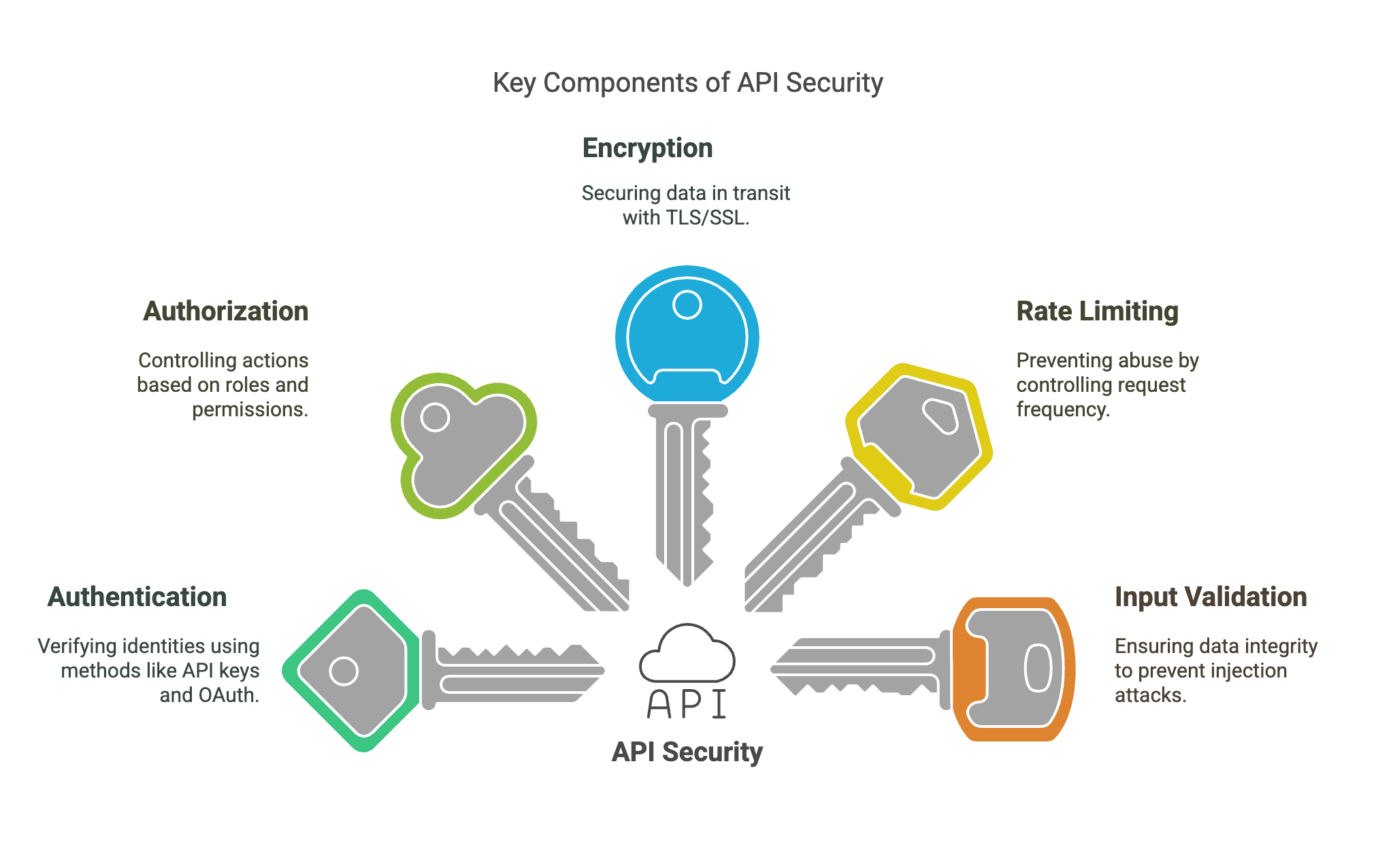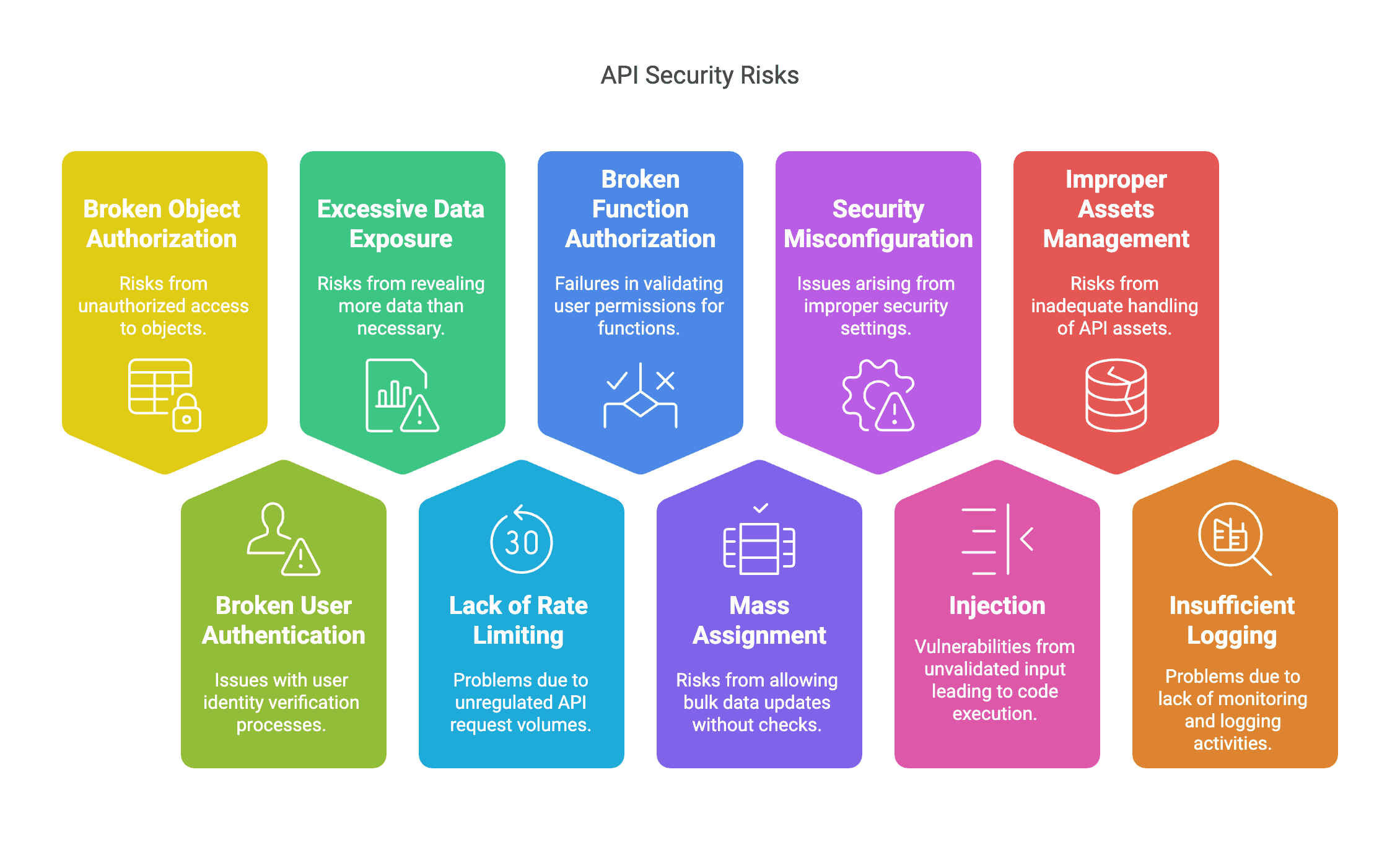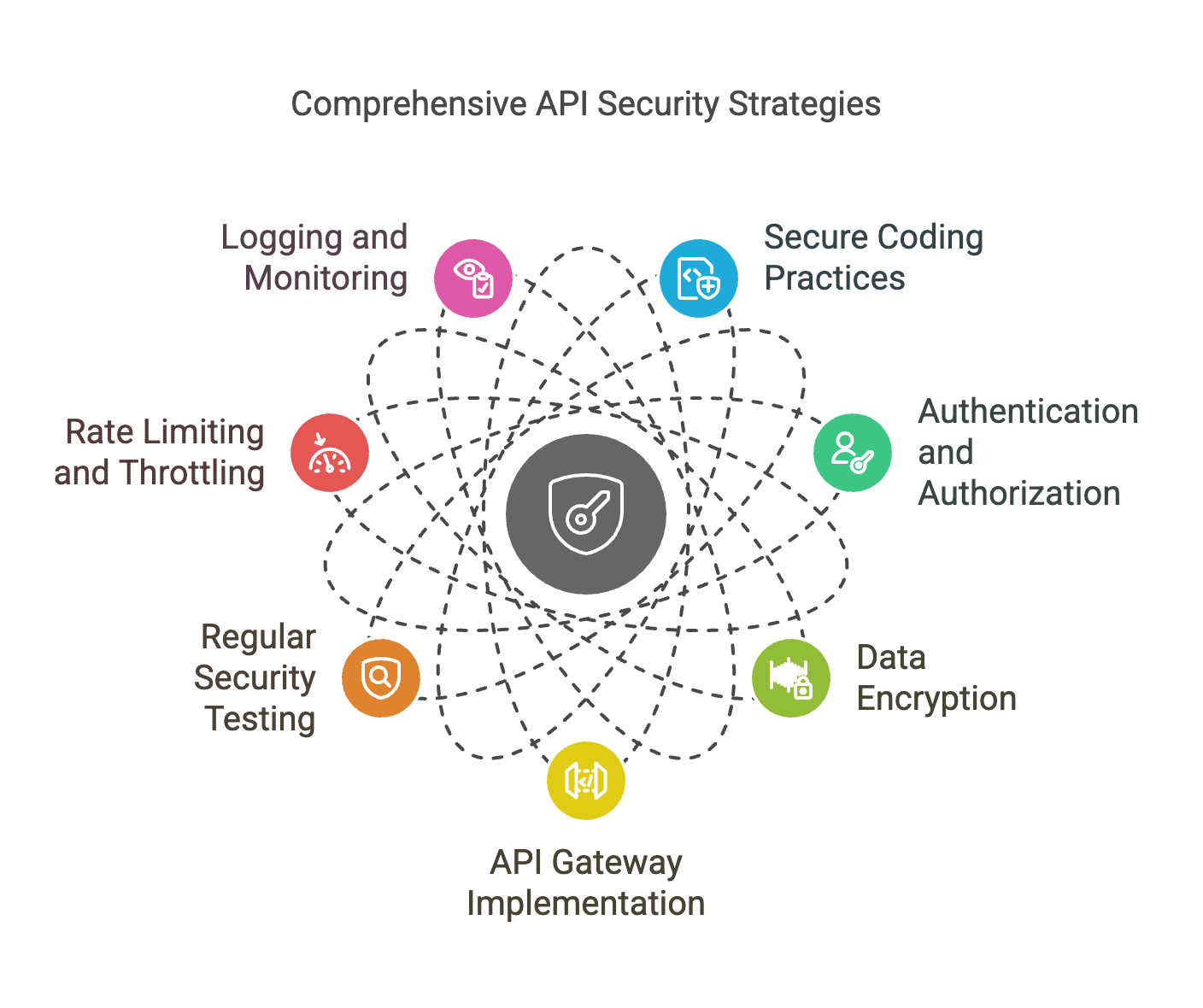In today's interconnected digital landscape, APIs (Application Programming Interfaces) have emerged as the linchpin of modern technology, enabling seamless communication and data exchange between applications, services, and systems. From mobile apps to cloud platforms, APIs power the functionality that drives our digital world. However, this increased connectivity also brings significant security risks. According to recent reports, API-related breaches and attacks are on the rise, with many organizations falling victim to vulnerabilities that expose sensitive data and compromise their digital infrastructure. This article aims to provide a comprehensive guide on API security, exploring its importance, common vulnerabilities, and best practices to protect APIs from cyber threats.
What is API Security?
API security protects APIs from unauthorized access, data breaches, and other malicious activities. It encompasses a range of measures designed to ensure the integrity, confidentiality, and availability of data exchanged through APIs. At its core, API security involves safeguarding the communication channels between applications and services, as well as the data that flows through them. APIs act as gateways for data exchange, allowing different systems to interact and share information. Given their critical role in modern technology, securing APIs is essential to prevent unauthorized access, data leakage, and other security incidents.
Key Components of API Security
- Authentication: Verifying the identity of users or systems accessing the API
- API keys
- OAuth tokens
- JWT (JSON Web Tokens)
- Multi-factor authentication
- Authorization: Determining what actions authenticated users can perform
- Role-based access control
- Least privilege principle
- Scope-based permissions
- Encryption: Protecting data in transit using TLS/SSL
- Rate Limiting: Preventing abuse by limiting request frequency
- Input Validation: Checking all data to prevent injection attacks

Understanding API Vulnerabilities
Unlike traditional web security, API security faces unique challenges. APIs are designed to be machine-to-machine interfaces with structured data exchanges, making traditional security approaches like web application firewalls less effective. Additionally, APIs often expose application logic and sensitive data in clear, documented ways that attackers can exploit if proper controls are absent.
Common API Vulnerabilities
Despite their importance, APIs are often plagued by vulnerabilities that malicious actors can exploit. Here are some of the most common API vulnerabilities:
1. Injection Attacks
Injection attacks occur when an attacker inserts malicious code into an API request to manipulate the underlying database or system. SQL injection, for example, involves inserting SQL code into an input field, potentially allowing the attacker to access or modify sensitive data. Command injection is another form of attack in which malicious commands are executed on the server. These attacks can lead to data breaches, unauthorized access, and system compromise.
2. Broken Authentication and Authorization
Weak or broken authentication mechanisms are a significant threat to API security. If an API does not properly verify the identity of users or systems, attackers can gain unauthorized access. Similarly, broken authorization can allow attackers to escalate their privileges and access data or functions they should not have access to. For example, an attacker might exploit a vulnerability to access another user's data or perform actions on behalf of another user.
3. Excessive Data Exposure
APIs often expose more data than necessary, which can lead to data leakage. For instance, an API might return sensitive information such as user passwords or personal details, even though they are not required for the requested operation. This excessive data exposure can be exploited by attackers to gather valuable information and launch further attacks.
4. Broken Object-Level Authorization
This vulnerability arises when an API fails to properly enforce access controls at the object level. For example, an attacker might be able to access or modify objects that do not belong to them. In a real-world scenario, a user could potentially access another user's account information by manipulating the API request.
5. Security Misconfiguration
Insecure default settings and misconfigured API gateways are common issues that can lead to security breaches. For example, an API might be configured to allow unrestricted access or fail to enforce proper encryption protocols. These misconfigurations can create openings for attackers to exploit.
6. Insufficient Logging and Monitoring
A lack of detailed logging and monitoring can leave organizations blind to potential threats. Without proper visibility into API activity, it becomes difficult to detect and respond to suspicious behavior. Insufficient logging can also hinder forensic analysis in the event of a security incident.
OWASP API Security Top 10
The Open Web Application Security Project (OWASP) API Security Top 10 provides a valuable framework for understanding the most critical security risks to APIs. These include:
- Broken Object Level Authorization
- Broken User Authentication
- Excessive Data Exposure
- Lack of Resources & Rate Limiting
- Broken Function Level Authorization
- Mass Assignment
- Security Misconfiguration
- Injection
- Improper Assets Management
- Insufficient Logging & Monitoring

Real-World API Security Incidents
Several high-profile API security incidents have highlighted the importance of robust API security measures. For example, in 2020, a major social media platform suffered a data breach due to a vulnerability in its API, exposing the personal information of millions of users. The incident led to significant financial losses, reputational damage, and legal implications for the company. Another example is a financial services company that experienced a breach due to a misconfigured API gateway, resulting in unauthorized access to customer accounts. These cases underscore the importance of proactive security measures and the need for organizations to prioritize API security.
Notable security incidents, such as the Equifax breach that exposed the personal information of 147 million people, the Facebook API vulnerability that exposed 50 million user accounts, and the T-Mobile breach affecting 37 million customers, highlight the devastating impact of API security failures.
Best Practices for API Security
Organizations should adopt a comprehensive approach to API security to mitigate these vulnerabilities and protect APIs from cyber threats. Here are some best practices:
1. Secure Coding Practices
Developers should follow secure coding practices to minimize vulnerabilities in API code. This includes validating and sanitizing all input data to prevent injection attacks and using secure coding frameworks and libraries with built-in security features.
2. Strong Authentication and Authorization
Implementing robust authentication and authorization mechanisms is crucial for API security. OAuth and JWT (JSON Web Tokens) are widely used protocols that provide secure ways to authenticate users and authorize access. Role-based access control (RBAC) can also help ensure that users have only the permissions they need.
3. Data Encryption
Encrypting data in transit and at rest is essential to protect sensitive information from being intercepted or stolen. Using strong encryption algorithms such as TLS (Transport Layer Security) for data in transit and AES (Advanced Encryption Standard) for data at rest can significantly enhance API security.
4. API Gateway Implementation
An API gateway acts as a central point of management and security enforcement for APIs. It can provide features such as rate limiting, authentication, and logging, making it easier to manage and secure API traffic. Modern API gateways often come with advanced security features that can help detect and prevent attacks.
5. Regular Security Testing
Regular security testing, including penetration testing and vulnerability scanning, is essential to identify and address potential vulnerabilities. Continuous monitoring and threat detection can help organizations stay ahead of attackers and respond quickly to any suspicious activity.
6. Rate Limiting and Throttling
Rate limiting and throttling can help prevent abuse and DDoS (Distributed Denial of Service) attacks by limiting the number of requests an API can handle from a single source within a specified time frame. Implementing effective rate-limiting strategies can protect APIs from being overwhelmed and ensure availability.
7. Logging and Monitoring
Detailed logging and monitoring are critical for detecting and responding to security incidents. SIEM (Security Information and Event Management) tools can provide real-time visibility into API activity, allowing organizations to identify and mitigate potential threats quickly.

Authentication and Authorization for APIs
Robust authentication and authorization form the cornerstone of API security. Several mechanisms offer varying levels of security:
1. Authentication Mechanisms
- Basic Authentication: Simple but insufficient alone for production environments
- API Keys: Easier to implement but lack granular access control
- Token-based Authentication: More secure and flexible
2. OAuth 2.0 and JWT
OAuth 2.0 and JWT (JSON Web Tokens) have emerged as industry standards. OAuth 2.0 provides a delegation framework where users can grant limited access to their resources without sharing credentials, while JWTs allow secure information transmission with digital signatures.
3. Role-Based Access Control
Implementation of Role-Based Access Control (RBAC) ensures that API consumers can only access the resources appropriate for their role. For heightened security, organizations are increasingly adopting Zero Trust principles—"never trust, always verify"—requiring continuous validation regardless of user location or network.
Security in the API Development Lifecycle
Security must be integrated throughout the entire API development lifecycle:
- Requirements Gathering: Security requirements should be captured alongside functional requirements from the outset.
- Threat Modeling: Using methodologies like STRIDE or DREAD helps identify potential threats early in the development process.
- Secure Coding Practices: Following established guidelines such as input validation, output encoding, proper error handling, and secure dependency management.
- API Security Testing:
- Static Application Security Testing (SAST) analyzes source code for security vulnerabilities
- Dynamic Application Security Testing (DAST) tests running applications
- Fuzz testing sends unexpected or random data to APIs to uncover exceptions
- Penetration testing simulates real-world attacks against API endpoints
- DevSecOps Integration: Automating security checks in CI/CD pipelines ensures that security tests are executed with every build and deployment.
API Gateway Security Features
API gateways serve as a centralized entry point for managing API traffic and implementing security controls:
- Access Control: Centrally manage authentication, authorization, and policy enforcement.
- Traffic Management: Control API traffic flow, implement rate limiting, and manage quota enforcement.
- Request/Response Validation: Validate requests against schema definitions and sanitize responses to prevent data leakage.
- Gateway Deployment Models: Options range from cloud-based solutions to on-premises deployments, each with different security implications.
- Microservices Security: Special consideration for securing service-to-service communications, implementing circuit breakers, and managing distributed authentication.
Monitoring, Logging, and Incident Response
Effective API security requires continuous vigilance:
- API Activity Monitoring: Real-time monitoring of API traffic, usage patterns, and performance metrics helps identify anomalies.
- Logging Strategies: Comprehensive logging of API access attempts, authentication events, and data modifications creates an audit trail for forensic analysis.
- Anomaly Detection: Leveraging behavioral analytics and machine learning to identify unusual patterns that might indicate security threats.
- Incident Response Planning: Developing and regularly testing incident response procedures specific to API security incidents.
- Post-Breach Analysis: Conduct thorough root cause analysis after incidents to implement improvements and prevent recurrence.
Compliance and Standards
APIs often handle sensitive data subject to regulatory requirements:
- Regulatory Compliance: Understanding how regulations like GDPR, HIPAA, PCI DSS, and CCPA apply to API implementations.
- Industry Standards: Following established standards like NIST Cybersecurity Framework or ISO 27001 to build comprehensive security programs.
- OpenAPI Specification: Leveraging security components within OpenAPI Specification to document security requirements.
- API Security Verification: Using standards like OWASP API Security Verification Standard (ASVS) to validate security controls.
- Privacy Considerations: Implementing data minimization principles, appropriate consent mechanisms, and privacy by design in API development.
Emerging Trends and the Future of API Security
As technology continues to evolve, so do the threats to API security. Emerging technologies such as AI and machine learning are being used to enhance threat detection and response capabilities. AI-powered systems can analyze vast amounts of data to identify patterns and anomalies that may indicate a security threat. Blockchain technology is also being explored for its potential to provide secure and tamper-proof API transactions. Additionally, regulatory and compliance considerations are becoming increasingly important. Regulations such as GDPR (General Data Protection Regulation) and CCPA (California Consumer Privacy Act) place strict requirements on data protection, making it essential for organizations to ensure their APIs are secure and compliant.
The API security landscape continues to evolve rapidly:
- AI and Machine Learning: Using advanced analytics to detect sophisticated attacks and anomalous behavior in API usage patterns.
- Shifting-Left Security: Integrating security earlier in the development lifecycle through tools, automation, and developer education.
- Serverless Security: Addressing the unique security challenges of APIs in serverless architectures, including ephemeral execution environments.
- Quantum Computing Implications: Preparing for post-quantum cryptography as quantum computing threatens traditional encryption methods.
- Emerging Standards: Following the development of new specifications like GraphQL security best practices and gRPC security models.
How to Protect API Security with EdgeOne?
Tencent EdgeOne combines edge computing, content delivery, and security capabilities into an integrated platform specifically designed to protect web applications and APIs. By positioning security controls at the network edge, organizations can identify and mitigate threats before they reach the origin infrastructure.
1. Advanced DDoS Protection
EdgeOne's distributed architecture provides robust protection against volumetric and application-layer DDoS attacks targeting APIs:
- Multi-terabit mitigation capacity across global points of presence
- Protocol-level protection against SYN floods and other attack vectors
- Specialized detection of API-focused DDoS attacks
- Automatic traffic scrubbing without impacting legitimate API requests
2. API-Aware Web Application Firewall
Unlike traditional WAFs, EdgeOne's security engine is designed with API-specific protections:
- Specialized rule sets aligned with the OWASP API Security Top 10
- Deep inspection of API payloads, including JSON and XML content
- Context-aware protection against injection and parameter tampering
- Custom rule capabilities for business logic vulnerabilities
3. Intelligent Bot Management
Controlling automated access to APIs is critical for security:
- Machine learning-powered bot classification system
- Behavioral analysis to identify malicious automation
- Protection against credential stuffing and account takeover attempts
- Customizable responses to different bot categories
4. Granular Rate Limiting
Prevent abuse while maintaining availability:
- Configurable rate limits based on multiple client attributes
- Progressive rate limiting that escalates restrictions for suspicious behavior
- Separate thresholds for different API endpoints based on sensitivity
- Custom response codes and headers for rate-limited requests
As part of a comprehensive API security strategy, Tencent EdgeOne helps organizations implement the defense-in-depth approach recommended throughout this article, protecting the network edge to the application core.
Sign up and start a free trial with us now!
Conclusion
API security is a critical component of modern cybersecurity, given the central role APIs play in our digital infrastructure. By understanding common vulnerabilities and adopting best practices such as secure coding, strong authentication, encryption, and regular security testing, organizations can significantly reduce the risk of API-related security incidents. Real-world examples of API breaches highlight the importance of proactive security measures and the potential consequences of neglecting API security. As technology advances, staying ahead of emerging threats and ensuring compliance with regulatory requirements will be essential for maintaining the integrity and confidentiality of data in an interconnected world. In conclusion, prioritizing API security is not just a best practice—it is a necessity for protecting digital assets and ensuring the trust of users and stakeholders.
FAQs about API Security
Q1: What is API security?
A1: API security refers to the practices, protocols, and tools used to protect Application Programming Interfaces (APIs) from attacks and unauthorized access. It involves securing the data and services that APIs expose by implementing authentication, authorization, encryption, rate limiting, and other protective measures to ensure that only legitimate users and applications can access and use the API.
Q2: Why is API security important?
A2: API security is critical because APIs expose application logic and sensitive data, making them an attractive target for attackers. Insecure APIs can lead to data breaches, unauthorized access, data theft, service disruptions, and compliance violations. As organizations increasingly rely on APIs to connect services and share data, securing these interfaces becomes essential to maintaining overall security posture.
Q3: What are the most common API security threats?
A3: Common API security threats include:
- Broken authentication and authorization
- Injection attacks (SQL, NoSQL, command injection)
- Excessive data exposure
- Lack of rate limiting leading to DOS attacks
- Broken function level authorization
- Mass assignment vulnerabilities
- Security misconfigurations
- Man-in-the-middle attacks
- API parameter tampering
- Insufficient logging and monitoring
Q4: What authentication methods are recommended for APIs?
A4: Recommended authentication methods include:
- OAuth 2.0 (especially for third-party access)
- JWT (JSON Web Tokens)
- API keys (for simple use cases)
- mTLS (Mutual TLS) for service-to-service communication
- OpenID Connect (for user authentication) Multi-factor authentication should be implemented when possible for enhanced security.
Q5: How should I handle sensitive data in API responses?
A5: To handle sensitive data properly:
- Use data minimization (return only what's needed)
- Implement field-level encryption for sensitive data
- Apply proper authorization before returning sensitive data
- Redact sensitive data in logs and error messages
- Use HTTPS for transport encryption
- Consider different response structures based on user roles
- Implement data masking when appropriate
Q6: What is rate limiting and why is it important?
A6: Rate limiting restricts how many API requests a user or client can make within a specific time period. It's important because it protects APIs from abuse, prevents denial-of-service attacks, manages load on backend systems, reduces the impact of API scraping, and helps maintain service availability for all users.
Q7: How should I test the security of my APIs?
A7: Comprehensive API security testing should include:
- Automated security scanning with specialized API tools
- Penetration testing specifically targeting API endpoints
- Fuzz testing to identify unexpected behaviors
- Authentication and authorization testing
- Input validation testing
- Rate limit testing
- Business logic abuse testing
- Integration with CI/CD pipelines for continuous security validation
Q8: What is an API gateway and how does it improve security?
A8: An API gateway is a service that sits between clients and your backend services, acting as a reverse proxy to accept API calls and route them to appropriate services. It improves security by centralizing authentication, implementing rate limiting, providing request validation, enabling logging and monitoring, facilitating TLS termination, and offering additional security controls in one managed layer.
Q9: Should I use an API management platform for security?
A9: API management platforms provide significant security benefits by offering built-in features like authentication, authorization, rate limiting, analytics, monitoring, and developer controls. They're especially valuable for organizations with multiple APIs or those needing governance at scale. However, they require proper configuration and shouldn't replace secure API design and development practices.
Q10: What are zero-trust principles for API security?
A10: Zero trust for APIs means:
- Never trusting by default, always verifying
- Implementing strict authentication for every API request
- Applying the principle of least privilege for all API access
- Continuous validation rather than one-time authentication
- Microsegmentation of API resources
- Monitoring and logging all API activities
- Implementing context-aware access controls
- Encrypting data in transit and at rest

